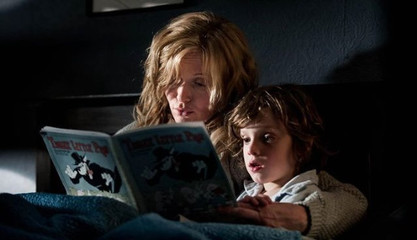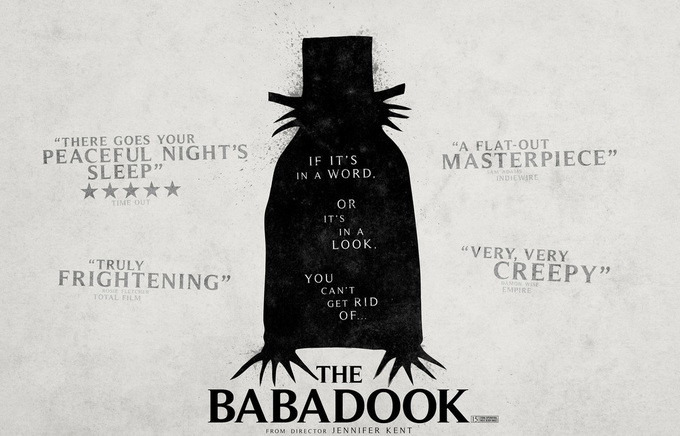
CAST & CREW
Featuring Essie Davis
Noah Wiseman
Hayley Mc Elhinney
Written and Directed by Jennifer Kent
Not Rated 95 Mins.
Featuring Essie Davis
Noah Wiseman
Hayley Mc Elhinney
Written and Directed by Jennifer Kent
Not Rated 95 Mins.
Reviewed by Michael Phillips
Here's one of the strongest feature film debuts in a long time, in any genre. Currently on demand and making its way into a few brave theaters, "The Babadook" comes from Australian writer-director Jennifer Kent, whose short film "Monster," made nearly a decade ago, inspired her full-length treatment of the same story.
That story deals in familiar tropes having to do with a troubled young boy, his widowed mother and a not-so-imaginary creature, sprung from a malevolent pop-up storybook. But Kent has taste, an eye and a knack for brisk, accelerated pacing. In the case of "The Babadook," familiarity breeds an eerily gratifying contentment.
A first-rate performance guides the tale, which is typically not the case with contemporary horror movies. Essie Davis is well-known in Australia and has won awards for her stage work in London and New York, but she'll be new to most movie audiences. She plays Amelia, an elder-care worker whose husband died in a car accident nearly seven years earlier. The accident happened on the way to the hospital, where their son, Samuel, was born.
Since then, mother and boy have lived in a tragedy-clouded haze in their ramshackle house, whose rooms are painted in unsettling grayish-blue tones. The house is practically begging for trouble. Out of nowhere, the Babadook storybook appears at the doorstep. The monster in the book is depicted as terrorizing a young boy after being allowed inside the boy's house. Samuel begins seeing him for real, and the boy, played by a game, wide-eyed Noah Wiseman, lives in fear of losing his remaining parent to the monster.
The Babadook clearly digs Edward Gorey; he's a Victorian-looking fellow with a stovepipe hat, long, Nosferatu-like fingers and terrible teeth borrowed from Maurice Sendak's wild things. Amelia descends into sleep-deprived madness as she, too, realizes the monster is no figment. As Amelia becomes the unwilling host for the Babadook, this stressed-out mother figure, as writer-director Kent herself suggested, turns into a combination of Shelley Duvall and Jack Nicholson from "The Shining."
Full of shadow and insinuation, "The Babadook" owes some visual touches to "Nosferatu" and "The Cabinet of Dr. Caligari." In their state of justified paranoia, Amelia and Samuel consume untold hours of late-night television, everything from Disney's "Three Little Pigs" to "The Strange Love of Martha Ivers." Little things indicate the presence of their tormentor, from flickering light bulbs to shards of glass in a bowl of soup. It sounds miserably manipulative and exploitative, but that's horror for you: The right artists can put terrible, painful emotions to work inside scares that add up to more than "boo!" (Or, in the parlance of splatter horror, "blech.")
The blood and gore in "The Babadook" is blessedly restrained by modern standards. Is the sinister force a manifestation of Amelia's grief? Is it her late husband in disguise? Could Kent's debut film actually be recut as a nonsupernatural drama about a single parent willing to do nearly anything for a decent night's sleep? Any horror film offering more than one answer to its central question is ahead of the game. "The Babadook" is a tonic, easily the best mainstream horror since last year's "The Conjuring."
And special thanks to illustrator Alexander Juhasz for the Babadook book itself, whose pages are given just the right amount of screen time.
Here's one of the strongest feature film debuts in a long time, in any genre. Currently on demand and making its way into a few brave theaters, "The Babadook" comes from Australian writer-director Jennifer Kent, whose short film "Monster," made nearly a decade ago, inspired her full-length treatment of the same story.
That story deals in familiar tropes having to do with a troubled young boy, his widowed mother and a not-so-imaginary creature, sprung from a malevolent pop-up storybook. But Kent has taste, an eye and a knack for brisk, accelerated pacing. In the case of "The Babadook," familiarity breeds an eerily gratifying contentment.
A first-rate performance guides the tale, which is typically not the case with contemporary horror movies. Essie Davis is well-known in Australia and has won awards for her stage work in London and New York, but she'll be new to most movie audiences. She plays Amelia, an elder-care worker whose husband died in a car accident nearly seven years earlier. The accident happened on the way to the hospital, where their son, Samuel, was born.
Since then, mother and boy have lived in a tragedy-clouded haze in their ramshackle house, whose rooms are painted in unsettling grayish-blue tones. The house is practically begging for trouble. Out of nowhere, the Babadook storybook appears at the doorstep. The monster in the book is depicted as terrorizing a young boy after being allowed inside the boy's house. Samuel begins seeing him for real, and the boy, played by a game, wide-eyed Noah Wiseman, lives in fear of losing his remaining parent to the monster.
The Babadook clearly digs Edward Gorey; he's a Victorian-looking fellow with a stovepipe hat, long, Nosferatu-like fingers and terrible teeth borrowed from Maurice Sendak's wild things. Amelia descends into sleep-deprived madness as she, too, realizes the monster is no figment. As Amelia becomes the unwilling host for the Babadook, this stressed-out mother figure, as writer-director Kent herself suggested, turns into a combination of Shelley Duvall and Jack Nicholson from "The Shining."
Full of shadow and insinuation, "The Babadook" owes some visual touches to "Nosferatu" and "The Cabinet of Dr. Caligari." In their state of justified paranoia, Amelia and Samuel consume untold hours of late-night television, everything from Disney's "Three Little Pigs" to "The Strange Love of Martha Ivers." Little things indicate the presence of their tormentor, from flickering light bulbs to shards of glass in a bowl of soup. It sounds miserably manipulative and exploitative, but that's horror for you: The right artists can put terrible, painful emotions to work inside scares that add up to more than "boo!" (Or, in the parlance of splatter horror, "blech.")
The blood and gore in "The Babadook" is blessedly restrained by modern standards. Is the sinister force a manifestation of Amelia's grief? Is it her late husband in disguise? Could Kent's debut film actually be recut as a nonsupernatural drama about a single parent willing to do nearly anything for a decent night's sleep? Any horror film offering more than one answer to its central question is ahead of the game. "The Babadook" is a tonic, easily the best mainstream horror since last year's "The Conjuring."
And special thanks to illustrator Alexander Juhasz for the Babadook book itself, whose pages are given just the right amount of screen time.






